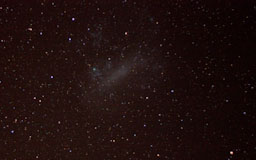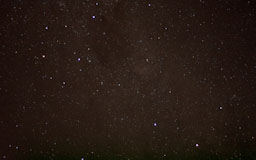Gallery - AstroPhotography
Having read about the recent BBC Stargazing Live event in the UK (A three
day television event featuring live hosts discussing star gazing and
presenting a variety of pre-recorded related short films) one of the parts
that piqued my interest was the astrophotography. Particularly how they
stressed that it was possible to get decent results with fairly modest
equipment - primarily you needed an SLR camera and a tripod. So I read the
advice they gave and figured I would give it a go myself. The results from
that are what you see below.
Now while I enjoyed myself I would temper their advice a bit. A cable
release I think is horribly important to have. You can kinda make do with
using the shutter release timer but in my experience without a heavy tripod
that can damp down the vibrations quickly you still get a fair bit of camera
shake - even with a good ten second delay from button press to shutter
release. The suggestion of using a piece of card suffers from two issues -
first unless your card is matt black then stray side light can be easily
reflected into the lens. Second using the card you cut into the exposure time
your camera supports - most prosumer models do support a bulb mode (but you
definitely want a cable release to use it) and otherwise have an upper limit
of thirty seconds to work with. Because of the earth's rotation most of the
time you will only want about fifteen seconds of exposure to avoid the stars
begining to streak so the card doesn't hurt there too much but if you really
want the full thirty seconds then the card simply isn't good.
But otherwise they were on the money - it is actually amazing what you can
capture with fairly simple equipment. My other big tip is simply to use the
fastest glass you have. For all the star field shots here I used my 50mm prime
F1.8 lens. Nikon and Canon both have extremely cheap versions of these lenses
and they should part of any semi serious camera enthusiasts kit. The fast
glass gives you the deeper star fields thanks to the extra light collecting
ability and while focus is a huge issue at F1.8 there is a really simple
trick to help here.
That trick is Liveview. My 450D has this and it is an older model now so
pretty much any new SLR camera bought in the last three years (so 2007 or
newer) will most likely have it. This simply drops the shutter down and feeds
the sensor output directly to the LCD screen. You can then use that for
composition and focusing. Particularly useful is the 5x zoom rectangle -
simply position this over a bright star in your selected composition and then
zoom in to adjust and get the focus bang on. From the camera's point of view
the stars are all off at infinity anyway so focusing on one star somewhere in
your field of view will get them all in focus. As can be seen below.

A little harder to see and definitely harder to capture an image of with a camera is the Large Magellanic Cloud. This companion dwarf galaxy orbits the Milky Way at around 160,000 light years away.
|

This shouldn't be hard to identify - it is of course our Moon seen halfway through waxing. This gives the craters on the terminator line nice deep shadows that really make them stand out.
|

Here we see Orion, upside down compared to the Northern Hemisphere view with his sword extending upwards. If you look closely at the sword you can see the middle start isn't a star at all - it is the Orion Nebula.
|

This is a little harder to see, but down the bottom slightly to the left of the middle is the Pleiades cluster. A small stellar nursery of new stars about 440 light years away - comparatively speaking moderately close neighbours. Locally called Matariki it is used as a marker for the start of the new year hew in New Zealand.
|

This is a very familiar constellation in the Southern Hemisphere - the Southern cross with the two pointer stars. Perhaps most surprising to see once captured is the variety of star colour in the cross itself. To me they just look white and close to one of the horizonal stars of the cross is the very colour Jewel box cluster - sadly not quite visible in all its glory here.
|
I need to experiment a little more in how to reduce the light polution and
noise which still has softened these shots a bit. But still for a first
attempt at this I am pretty pleased with the results obtained. The other big
issue is simply sensor noise. I shot these at ISO 400 which is about as high I
dare go with the 450's sensor. Newer cameras are getting into acceptable ISO
performance even up around the 6400 mark so I have great hopes for replacing
the camera with a newer body and using that. In the meantime till I have some
money to do that I should explore my camera manual and see if there are some
longer term noise reduction features I can turn on. I have a vague
recollection I deliberately turn them off because for the other uses I put the
camera to they tended to get in the way.
Still as can be seen you definitely don't need a lot of kit to have a go
and it was a great deal of fun to go out for an evenings stargazing with my
cousin (who was also working her camera, so it will be interesting to see what
she got).
Philip R. Banks
Send Email




